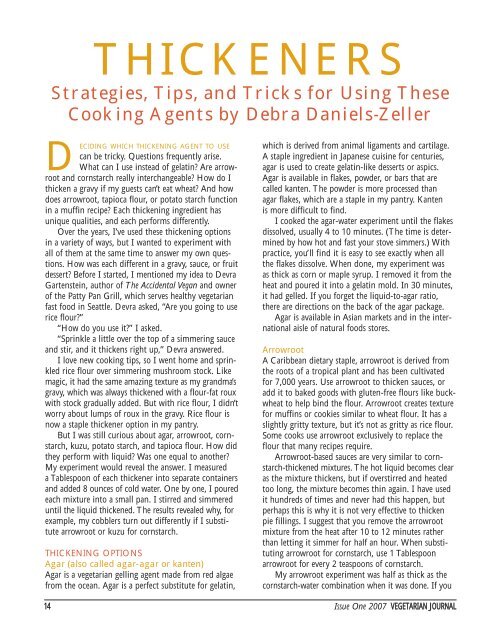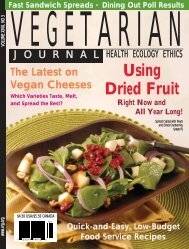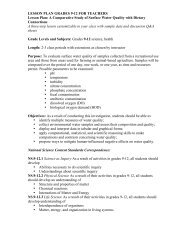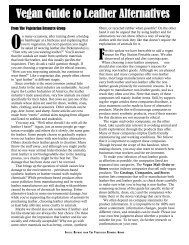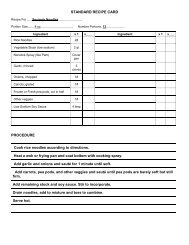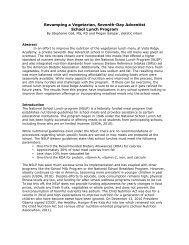Vegan Thickeners - The Vegetarian Resource Group
Vegan Thickeners - The Vegetarian Resource Group
Vegan Thickeners - The Vegetarian Resource Group
You also want an ePaper? Increase the reach of your titles
YUMPU automatically turns print PDFs into web optimized ePapers that Google loves.
THICKENERS<br />
Strategies, Tips, and Tricks for Using <strong>The</strong>se<br />
Cooking Agents by Debra Daniels-Zeller<br />
DECIDING WHICH THICKENING AGENT TO USE<br />
can be tricky. Questions frequently arise.<br />
What can I use instead of gelatin? Are arrowroot<br />
and cornstarch really interchangeable? How do I<br />
thicken a gravy if my guests can’t eat wheat? And how<br />
does arrowroot, tapioca flour, or potato starch function<br />
in a muffin recipe? Each thickening ingredient has<br />
unique qualities, and each performs differently.<br />
Over the years, I’ve used these thickening options<br />
in a variety of ways, but I wanted to experiment with<br />
all of them at the same time to answer my own questions.<br />
How was each different in a gravy, sauce, or fruit<br />
dessert? Before I started, I mentioned my idea to Devra<br />
Gartenstein, author of <strong>The</strong> Accidental <strong>Vegan</strong> and owner<br />
of the Patty Pan Grill, which serves healthy vegetarian<br />
fast food in Seattle. Devra asked, “Are you going to use<br />
rice flour?”<br />
“How do you use it?” I asked.<br />
“Sprinkle a little over the top of a simmering sauce<br />
and stir, and it thickens right up,” Devra answered.<br />
I love new cooking tips, so I went home and sprinkled<br />
rice flour over simmering mushroom stock. Like<br />
magic, it had the same amazing texture as my grandma’s<br />
gravy, which was always thickened with a flour-fat roux<br />
with stock gradually added. But with rice flour, I didn’t<br />
worry about lumps of roux in the gravy. Rice flour is<br />
now a staple thickener option in my pantry.<br />
But I was still curious about agar, arrowroot, cornstarch,<br />
kuzu, potato starch, and tapioca flour. How did<br />
they perform with liquid? Was one equal to another?<br />
My experiment would reveal the answer. I measured<br />
a Tablespoon of each thickener into separate containers<br />
and added 8 ounces of cold water. One by one, I poured<br />
each mixture into a small pan. I stirred and simmered<br />
until the liquid thickened. <strong>The</strong> results revealed why, for<br />
example, my cobblers turn out differently if I substitute<br />
arrowroot or kuzu for cornstarch.<br />
THICKENING OPTIONS<br />
Agar (also called agar-agar or kanten)<br />
Agar is a vegetarian gelling agent made from red algae<br />
from the ocean. Agar is a perfect substitute for gelatin,<br />
which is derived from animal ligaments and cartilage.<br />
A staple ingredient in Japanese cuisine for centuries,<br />
agar is used to create gelatin-like desserts or aspics.<br />
Agar is available in flakes, powder, or bars that are<br />
called kanten. <strong>The</strong> powder is more processed than<br />
agar flakes, which are a staple in my pantry. Kanten<br />
is more difficult to find.<br />
I cooked the agar-water experiment until the flakes<br />
dissolved, usually 4 to 10 minutes. (<strong>The</strong> time is determined<br />
by how hot and fast your stove simmers.) With<br />
practice, you’ll find it is easy to see exactly when all<br />
the flakes dissolve. When done, my experiment was<br />
as thick as corn or maple syrup. I removed it from the<br />
heat and poured it into a gelatin mold. In 30 minutes,<br />
it had gelled. If you forget the liquid-to-agar ratio,<br />
there are directions on the back of the agar package.<br />
Agar is available in Asian markets and in the international<br />
aisle of natural foods stores.<br />
Arrowroot<br />
A Caribbean dietary staple, arrowroot is derived from<br />
the roots of a tropical plant and has been cultivated<br />
for 7,000 years. Use arrowroot to thicken sauces, or<br />
add it to baked goods with gluten-free flours like buckwheat<br />
to help bind the flour. Arrowroot creates texture<br />
for muffins or cookies similar to wheat flour. It has a<br />
slightly gritty texture, but it’s not as gritty as rice flour.<br />
Some cooks use arrowroot exclusively to replace the<br />
flour that many recipes require.<br />
Arrowroot-based sauces are very similar to cornstarch-thickened<br />
mixtures. <strong>The</strong> hot liquid becomes clear<br />
as the mixture thickens, but if overstirred and heated<br />
too long, the mixture becomes thin again. I have used<br />
it hundreds of times and never had this happen, but<br />
perhaps this is why it is not very effective to thicken<br />
pie fillings. I suggest that you remove the arrowroot<br />
mixture from the heat after 10 to 12 minutes rather<br />
than letting it simmer for half an hour. When substituting<br />
arrowroot for cornstarch, use 1 Tablespoon<br />
arrowroot for every 2 teaspoons of cornstarch.<br />
My arrowroot experiment was half as thick as the<br />
cornstarch-water combination when it was done. If you<br />
14 Issue One 2007 VEGETARIAN JOURNAL


